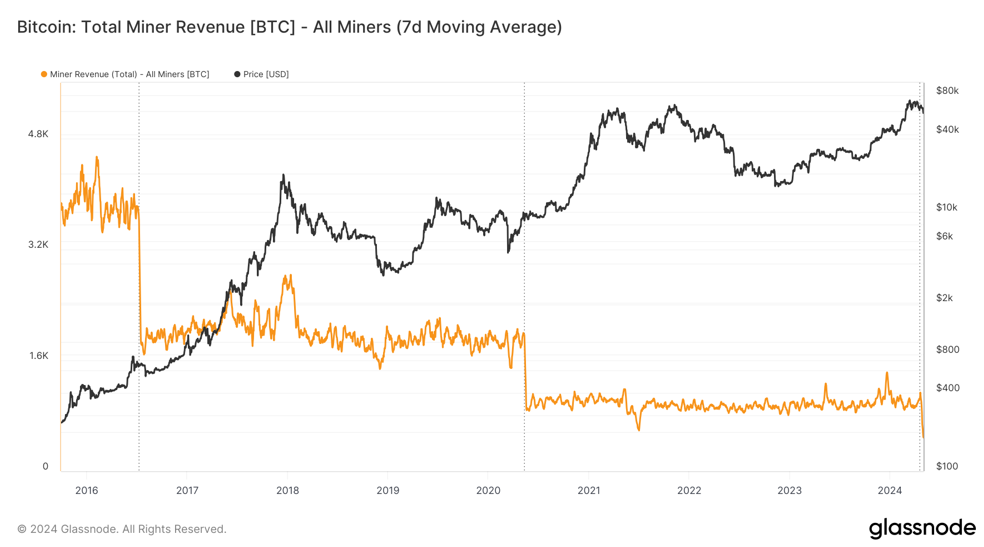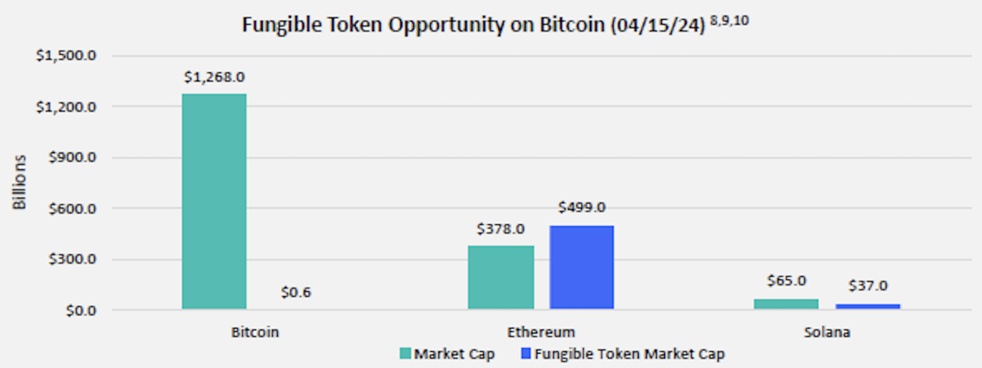The Bitcoin halving remains one of the most hyped events in the crypto industry. The fourth halving took place on April 20 and further decreased Bitcoins issuance rate. While the halving historically marked the start of a new bull market, it doesn’t go without risks.
One of the primary concerns surrounding Bitcoin is the sustainability of its network security as block rewards will continue to diminish over time. In that view, miners need an additional revenue stream to offset the declining income from newly issued Bitcoin units (Halving). Without this supplementary revenue, there's a risk that miners may withdraw their support to cover their operational costs. On one end, relying on Bitcoin's adoption as a global payments network is considered too risky due to its inherent volatility, despite the fact that it’ll continue to decrease as the institutionalization and adoption of the asset increases. Its distinctive attributes lend themselves more aptly to serving as a Store of Value (SOV) rather than a medium of exchange.
However, should Bitcoin progress into a worldwide computational platform akin to Ethereum and other prominent smart-contract platforms, the revenue potential could substantially increase, potentially addressing the network’s security budget concerns. This is where Ordinals, BRC20, and Runes come into play, extending a crucial lifeline of support to Bitcoin and its miners.
Analysis of Bitcoin mining revenues
To echo this thesis, examining miners' revenue over the years can give us further insights. As seen in figure 1, from July 9, 2016, to May 2020, bitcoin miners accrued an average of close to 1900-2000 BTC. In terms of USD, their earnings ranged from nearly $1 million in the months immediately following the halving to a peak of $2.5 million to $20 million leading up to the 2020 halving. However, USD revenue was highly volatile due to Bitcoin's price fluctuations during this third halving cycle. The fourth halving saw a comparable trend, with miners earning approximately 1000 BTC in total revenue over the subsequent four years. Yet, this began to shift slightly in 2023 with increased activity spurred by the release of Ordinals and subsequently BRC20. These two experimental standards signaled the early stages of Bitcoin evolving into a global app store similar to Ethereum. It also marked a pivotal moment in enhancing the economic prospects for miners, as the next two sections will unveil, while setting the stage for Runes protocol.

In January 2023, Bitcoin Ordinals made its debut, offering a method to inscribe data onto individual satoshi units, the smallest denomination of Bitcoin. In simpler terms, Ordinals facilitated the creation of Non-Fungible Tokens (NFTs) directly on the Bitcoin network without necessitating modifications to its codebase or the use of additional layers for functionality. Through Ordinals, users gained the ability to attach diverse forms of unique data such as text, images, and videos to each individual unit. However, this experimental standard faced criticism for potentially bloating the blockchain with what some consider as spam. Nonetheless, it marked an exciting innovation by enabling the creation and management of unique digital assets on the Bitcoin network. As of now, miners have amassed approximately 6,790 BTC from verifying transactions related to Ordinals, equivalent to nearly $400 million, to-date, as seen below.

First NFTs, then fungible tokens on Bitcoin
In March 2023, the BRC20 standard was introduced, expanding upon the Ordinals protocol to enable the development of experimental fungible tokens atop Bitcoin. It was met with more excitement as it facilitated experimentation across a broader landscape of applications, not just around tokenization initiatives in the form of NFTs. Despite boasting a current market capitalization nearing $2.2B, the majority of tokens within the ecosystem are memecoins such as SATS and ORDI and PUPS. That said, since its inception last year, Bitcoin miners have accumulated nearly 5000 BTC, ~$305M through approving transactions related to minting, deploying, and transferring BRC20 tokens, as shown in Figure 3.

While this increased revenue proved advantageous for miners to help them become sustainable over the long term, some criticized the experimental standard for congesting the Bitcoin blockchain. The congestion resulted in a sharp increase in transaction fees, soaring from an average of $1 - $2 to average of $30 during the initial hype in May 2023, and further escalating to an average of $40 per transaction by December 2023. This surge effectively priced out average users from interacting with the blockchain. To address some of the technical drawbacks associated with Ordinals and BRC20, the creator of the Ordinals standard proposed a more efficient alternative known as the Runes protocol.
Bitcoin Runes: a new standard
Runes streamlines the creation and management of fungible tokens on top of Bitcoin. It addresses the inefficiencies of the BRC20 standard, which have burdened the Bitcoin blockchain due to its inefficient data handling approach. Runes achieves this in two key ways. Firstly, it optimizes transaction fees by consolidating multiple Unspent Transaction Output (UTXO) transactions into one bundle, leveraging Bitcoin's accounting UTXO model. Additionally, it utilizes Bitcoin's script, OP_Return, to inscribe data directly onto the blockchain, which serves to assign and transfer Runes balances within the network's UTXOs. By minimizing data usage to 80 bytes, compared to BRC20's 4MB, Runes prevents unnecessary bloat on the Bitcoin blockchain.
At its core, the Runes protocol encompasses three fundamental functions crucial for users' interaction: Etching (Creation), Minting (Issuance), and Trading. In simplified terms, Etching involves the creation of a new template for a token, specifying details such as its name and supply. This template then becomes public on the Bitcoin blockchain. Minting, on the other hand, refers to the issuance of new tokens based on the template created through the Etching process. During this phase, the owner has the discretion to determine the quantity of tokens generated and their distribution. Finally, Trading enables users to exchange their Runes-based tokens. However, the trading process is more complex compared to traditional fungible tokens, as users are required to purchase the entire collection of a particular token. Some platforms, such as Unisat, offer a workaround through a split function, enabling users to buy only a portion of the collection. However, this process is not entirely intuitive and will require improvements to streamline its complexity for the average user.
That said, much like Ordinals and BRC20, Runes presents a continuation of the efforts aimed at addressing Bitcoin's security budget, providing miners with an alternative revenue source to mitigate their reliance on Bitcoin's subsidized rewards in the long run. To date, miners have earned about 2,184 BTC, valued at close to $133M in less than two weeks of trading activity, as illustrated in Figure 4. To that end, Runes has garnered widespread support from the outset, with multiple Tier 2 exchanges such as OKX and Gate.io already announcing the listing of early collections like UNCOMMON.GOODS and MEME.ECONOMICS, which were among the first collections minted. Additionally, Binance appears to be hinting at support for meme tokens like Wizard and Pups, which were also among the first tokens to migrate from BRC20 to the Runes standard. Meanwhile, NFT platforms like Magic Eden and Bitcoin-focused wallet provider, Unisat, are also joining the trend to capitalize on Runes’ growing popularity.

Just a short term hype?
Following the pattern of past hype cycles, we anticipate that the initial excitement surrounding Runes will gradually subside, followed by a surge of heightened activity in the long run. This trend is often observed because the initial wave of interest tends to be on meme tokens, which can be quickly deployed and attract the masses’ attention, but often don’t add substantial value. However, as time progresses, sophisticated primitives like exchanges, automated market makers, and other DeFi lego blocks will begin emerging. We’re already seeing the early innings of this embryonic growth with the announcement of OpenDelta’s Runes-based synthetic stablecoin (USDO) that is powered by Bitcoin derivatives. A product reminiscent of Ethena’s USDe synthetic dollar on the Ethereum network. Another notable instance is the entry of Animoca Brands, the renowned Hong Kong-based game software company, into the runes ecosystem through their backing of the Opal Foundation.
These advancements will enhance Bitcoin's capabilities at the application layer, simplifying the token trading process on the Bitcoin network, akin to how ERC20/ERC721 standardized token trading on the Ethereum network. Additionally, they will contribute to the blooming of the Bitcoin on-chain ecosystem. In fact, when considering Bitcoin's untapped market potential to establish its own fungible market universe compared to other smart contract platforms, it becomes evident that there is substantial room for growth for this new generation of tokens, as depicted in Figure 5.





